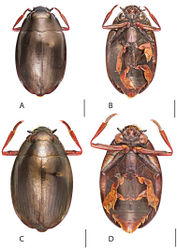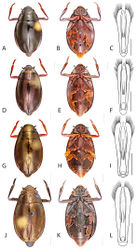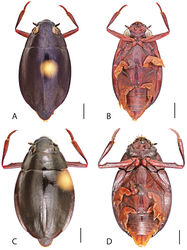Dineutus serrulatus serrulatus
| Notice: | This page is derived from the original publication listed below, whose author(s) should always be credited. Further contributors may edit and improve the content of this page and, consequently, need to be credited as well (see page history). Any assessment of factual correctness requires a careful review of the original article as well as of subsequent contributions.
If you are uncertain whether your planned contribution is correct or not, we suggest that you use the associated discussion page instead of editing the page directly. This page should be cited as follows (rationale):
Citation formats to copy and paste
BibTeX: @article{Gustafson2015ZooKeys, RIS/ Endnote: TY - JOUR Wikipedia/ Citizendium: <ref name="Gustafson2015ZooKeys">{{Citation See also the citation download page at the journal. |
Ordo: Coleoptera
Familia: Gyrinidae
Genus: Dineutus
Name
Dineutus serrulatus LeConte, 1868 – Wikispecies link – Pensoft Profile
- Dineutus serrulatus LeConte 1868[1]: 366, Dineutus (Cyclinus) serrulatus: Ochs 1926a[2]: 137. Dineutus serrulatus serrulatus: Wood 1968[3]: 4, Dineutus serrulatus: Ciegler et al. 2003[4]: 16.
Type locality
U.S.A., “middle states” (which according to MCZ type database could be Maryland, Delaware, New York, New Jersey, Pennsylvania, Connecticut, Rhode Island), but according to Wood (1968)[3] this subspecies is found only in Alabama, Florida, and Georgia. See distribution for more information.
Specimens examined
117
Type material examined
Lectotype (designated by Wood 1968[3]: 3) (♂ pinned) “[pink disc]// Type/ 6094 [red label, Type in typed black ink, 6094 handwritten black ink]// Dineutus serrulatus Lec. [white label, hand written, handwriting appears to be LeConte’s]//” deposited in MCZ.
Material examined
U.S.A.: Florida: Alachua Co., 10.ii.1949, leg. S.B. Mansell (1 ex. FSCA); same as previous except: 29.iv.1950, leg. T.G. Stewart (1 ex. FSCA); Hatchet Creek, 25.v.1985, leg. D.W. Johnson, water (1 ex. FSCA); Hogtown Creek, 28.vi.1976, leg. J.B. Heppner (6 ex. FSCA); Gainesville, 14.iii.1963, leg. R.E. Woodruff, in blacklight trap (1 ex. FSCA); Bradford Co., 3.ii.1949, leg. B.W. Cooper, (2 ex. FSCA); same as previous except: 16.vii.1934, leg. J.D. Beamer (1 ex. KSEM); Columbia Co., O’Leno State Park,12.ii.1966, leg. F.W. Mead (17 ex. FSCA); same as previous except: 11.xii.1954, leg. C.N. Patton (1 ex. FSCA); Dade Co., iii.1954, leg. L.N. Bell, (1 ex. FSCA); Cutler, 26.xi.1960, leg. D.R. Paulson, (3 ex. FSCA); Canal at Pinecrest, 29.xii.1982, leg. F.N. Young, #2977 (1 ex. FSCA); Hernando Co., Weekiwachee Spring, “Sta.4”, 3.vi.1953, leg. W.C. Sloan, (19 ex. FSCA); same as previous except: 3.vi.1954 (18 ex. FSCA); Highlands Co., Archbold Biol. Sta., 7.vi.1975, leg. L.L. Lampert (4 ex. FSCA); same as previous except: 2.iv.1979, leg. L.L. Lampert Jr. (2 ex. FSCA); Highlands Hammock State. Prk., 3.v.1974, leg. J.B. Heppner, at (UV) blacklight (9 ex. FSCA); same as previous except: 15.iii.1974, leg. R.E. Beer (1 ex. KSEM); Hillsborough Co., Morris Bridge Rd., 5.vii.1975, leg. S. Janisch (1 ex. FSCA); same as previous except: 4.vii.1977, leg. Boyd (1 ex. FSCA); “U.S.F Golf Course”, 21.v.1975, leg. “R.H” (1 ex. FSCA); “U.S.F. Campus”, 26.vi.1972 (1 ex. FSCA); same a previous except: 8.v.1979, leg. “S.T.” (1 ex. FSCA); Levy Co., 6.v.1950, leg. S.R. Young, (2 ex. FSCA); Okaloosa Co., 3mi S. of Holt Log Lake Bridge, 4.x.1966, leg. P.A. Thomas (9 ex. FSCA); Pasco Co., Crystal Springs, vii.1972 (1 ex. FSCA); same a previous except: 5.i.1975, leg. M. Lopez (1 ex. FSCA); Crystal Springs, Hill City, 5.i.1975, leg. J. Ward (1 ex. FSCA); Crystal Springs, “Hillshore”, 5.i.1975, leg. Diemer, (1 ex. FSCA); Polk Co., Mulberry, 24.vii.1972 (1 ex. FSCA); Seminole Co., 5.iv.1941, leg. M.J. Westfall Jr. (1 ex. FSCA); Taylor Co., Esconfina R. at US 98, 31.v.1987, leg. F.N. Young, #3189 (5 ex. FSCA); Volusia Co., Daytona Beach, 18.iv.1960, leg. R.E. Woodruff (1 ex. FSCA).
Diagnosis
Male (Fig. 40C–D): Size: 9.9–11.7 mm. Body form broadly elongate oval; elytral apices flatly rounded, rarely with sutural angle produced to a point, apicolateral sinuation strongly present, serration and irregularities present apically near sutural production, elytral apices weakly deflexed, reticulation of pronotal fine, producing a polished appearance; elytral striae faintly evident, most evident on the medial portion of the elytral disc; profemora with large sub-apicoventral tooth; protibiae subsinuate to weakly-subsinuate; mesotarsal claws (Fig. 41C) small and of similar size, with ventral margin with a more less developed smooth denticle; venter lightly colored, red in coloration for its entirety, with the mesothoracic and metathoracic legs usually lighter in coloration, as well as apex of abdomen; Aedeagus (Fig. 41A, B, D) with median lobe in dorsal view as long as parameres, highly parallel sided, narrowed in apical 1/4, apex flatly to regularly rounded, in lateral view median lobe weakly curved dorsally after basal 1/3, in ventral view sperm-groove broad, parameres in apical 1/3 weakly laterally expanded, apically obliquely flatly rounded to truncate.
Female (Fig. 40A–B): Size: 9.6–11.3 mm. Body form elongate oval; elytral apices flatly rounded to flatly rounded toward apical production, sutural angle often produced to a point, apicolateral sinuation shallow, serration present apically near sutural production, elytral apices weakly deflexed, reticulation of pronotal fine, producing a polished appearance; elytral striae faintly evident, most evident on the medial portion of the elytral disc, profemora without sub-apicoventral tooth; protibiae club shaped, with lateral margin flatly round; venter lightly colored, red in coloration for its entirety, with the mesothoracic and metathoracic legs usually lighter in coloration, as well as apex of abdomen.
Differential diagnosis
Dineutus serrulatus serrulatus is unique among all other North American Dineutus in being elongate oval and attenuated anteriorly, having the elytral apices flatly rounded with serration present apically near the suture, both sexes with apicolateral sinuation present, being deeply sinuate in the males, males with a large and highly acute sub-apicoventral profemoral tooth, and in the form of the aedeagus. The species most similar to Dineutus serrulatus serrulatus is Dineutus carolinus. Both Dineutus serrulatus serrulatus and Dineutus carolinus have the elytral apices with serrations and or irregularities present apically. Dineutus serrulatus serrulatus of both sexes can be distinguished fairly easily from Dineutus carolinus in the color of the venter. The venter of Dineutus serrulatus serrulatus is more lightly colored (Fig. 40B, D), varying from light orange red to a dark orange red, while that of Dineutus carolinus is darkly colored, dark reddish brown to black (Fig. 10B, D). The body form between the two species also differs in Dineutus serrulatus serrulatus is more attenuated anteriorly, while Dineutus carolinus is more regularly elongate oval in body form
Males of Dineutus serrulatus serrulatus can be further distinguished from Dineutus carolinus in having a strong apicolateral sinuation present in the elytra. Males of Dineutus carolinus do not have apicolateral sinuation present. The profemoral sub-apicoventral tooth will also separate the species in that Dineutus serrulatus serrulatus has a very large acute tooth, while that of Dineutus carolinus is much smaller. The mesotarsal claws are also very different between these two species, in Dineutus serrulatus serrulatus the ventral margin has a denticle (Fig. 41C), while in Dineutus carolinus the ventral-margins are shallowly rounded and without a denticle (Fig. 11C). The male aedeagus will allow unambiguous separation of the two species. In Dineutus serrulatus serrulatus the median lobe of the aedeagus (Fig. 41A) is highly parallel sided, being only narrowed in the apical 1/4 while Dineutus carolinus the aedeagus is gradually tapered from base to apex (Fig. 11A). The parameres differ drastically between the species. In Dineutus serrulatus serrulatus the parameres are much more narrow and are obliquely truncate to obliquely flatly rounded, while in Dineutus carolinus the parameres are thick and broad and are apically flatly rounded, not obliquely angled.
Females of Dineutus serrulatus serrulatus are more difficult to distinguish from females of Dineutus carolinus as both have an apicolateral sinuation present in the elytra. But the venter coloration and body form differences should allow separation of these two species.
Dineutus serrulatus serrulatus can be distinguished from Dineutus serrulatus analis by the characters given in the key.
Distribution
(Fig. 53C). Mostly known from extreme southeastern United States, primarily from Florida (Epler 2010[5]; Folkerts 1978[6]; Régimbart 1882[7]; Sanderson 1982[8]; Wood 1968[3]; Young 1954[9]).
Habitat
Dineutus serrulatus serrulatus is a lotic species (Young 1954[9]; Wood 1968[3]) and appears to occupy small streams below 500 feet in elevation (Wood 1968[3]). In Florida Dineutus serrulatus serrulatus is commonly found in small, rather swift, sand bottomed streams of the uplands throughout the northern and central peninsular region, as well as in the western uplands (Young 1954[9]). Young (1954)[9] suggests that Dineutus serrulatus serrulatus is more rarely found in the swifter streams of the flatwoods. Young (1954)[9] also notes that Dineutus serrulatus serrulatus is rarely found in the same habitat as Dineutus angustus in the peninsular uplands of Florida, and attributes this to Dineutus serrulatus serrulatus being found in slightly more acidic streams.
Discussion
It should be pointed out that Dineutus serrulatus serrulatus has the more narrower of the two subspecies ranges, occupying the most southeastern portion of the species range (Fig. 53C).
Taxon Treatment
- Gustafson, G; Miller, K; 2015: The New World whirligig beetles of the genus Dineutus Macleay, 1825 (Coleoptera, Gyrinidae, Gyrininae, Dineutini) ZooKeys, (476): 1-135. doi
Images
|
Other References
- ↑ LeConte J (1868) The Gyrinidae of America, north of Mexico. Proceedings of the Academy of Natural Sciences of Philadelphia 20: 365–373.
- ↑ Ochs G (1926a) Die Dineutini. 2. Tribus der Unterfamilien Enhydrinae Fam. Gyrinidae (Col). A. Aligemeiner Teil. Entomologische Zeitschrift 40: 129–140.
- ↑ 3.0 3.1 3.2 3.3 3.4 3.5 Wood F (1968) The taxonomic status of Dineutus serrulatus and Dineutus analis in North America (Gyrinidae: Coleoptera). Proceedings of the United States National Museum 124: 1–9. doi: 10.5479/si.00963801.124-3646.1
- ↑ Ciegler J, Morse J, Wheeler A, Activities C (2003) Water beetles of South Carolina: (Coleoptera: Gyrinidae, Haliplidae, Noteridae, Dytiscidae, Hydrophilidae, Hydraenidae, Scirtidae, Elmidae, Dryopidae, Limnichidae, Heteroceridae, Psephenidae, Ptilodactylidae, and Chelonariidae). Clemson University Public Service Pub., 210 pp.
- ↑ Epler J (2010) The Water Beetles of Florida - an identification manual for the families Chrysomelidae, Curculionidae, Dryopidae, Dytiscidae, Elmidae, Gyrinidae, Haliplidae, Helophoridae, Hydraenidae, Hydrochidae, Hydrophilidae, Noteridae, Psephenidae, Ptilodactylidae and Scirtidae, 399 + iv.
- ↑ Folkerts G (1978) A preliminary checklist of the Hydradephaga (Coleoptera) of Alabama. The Coleopterists Bulletin 32: 345–347.
- ↑ Régimbart M (1882) Essai monographique de la famille des Gyrinidae. 1e partie. Annales de la Société entomologique de France (6): 379–458 + 373 pls.
- ↑ Sanderson M (1982) Gyrinidae. In: Brigham A Brigham W Gnilka A (Eds) Aquatic Insects and Oligochaetes of North and South Carolina. Midwest Aquatic Enterprises, Mahomet, Ill, 10.29–10.38.
- ↑ 9.0 9.1 9.2 9.3 9.4 Young F (1954) The Water Beetles of Florida. In: Florida Uo (Ed. ) Unveristy of Florida Studies Biological Science Series, Gainesville, 238 pp.





